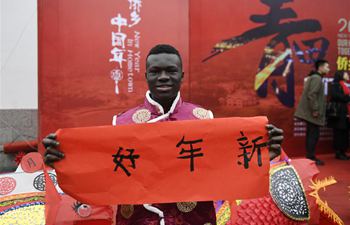CHANGCHUN, Feb. 11 (Xinhua) -- A mobile phone-sized box may help patients detect acute heart failure or cancer, at any time, without any medical assistance. A Chinese research program is trying to make this "family physician" dream come true.
Chinese scientists have developed a biosensor based on an optical microfiber coupler (OMC) to identify one ultra sensitive biomarker of acute myocardial infarction (AMI), the medical term for a heart attack, which could make detection much easier and less expensive.
A team of scientists from Changchun Institute of Optics, Fine Mechanics and Physics (CIOFMP) under the Chinese Academy of Sciences have dedicated 16 years to researching this label-free immunosensor and published their findings online in the scientific journal, Biosensors and Bioelectronics earlier this month.
"The goal of this research is to make detection of heart attack biomarkers more sensitive and convenient, so as to identify the disease at an earlier stage," said Zhou Wenchao, a researcher at the CIOFMP State Key Laboratory of Applied Optics.
Despite advancements in modern medicine, heart attacks remain a common, life-threatening condition.
According to Zhou, early diagnosis can decrease the fatality rate of heart attacks. However, patients can currently only go to hospitals for testing, instead of testing themselves at home.
Hospitals usually use a biochemical technique called enzyme immunoassay (EIA) to track AMI biomarkers, which takes one to two hours for one single test and requires a 0.1 ng/ml clinical cut-off.
Chinese researchers are trying to improve the situation by developing the OMC. "Since 2002, we've recorded countless failures while trying to find the way to improve the test sensitivity and accuracy, and maintain its stability. Now each test only takes 10 minutes and costs less than the EIA approach," said Wu Yihui, head researcher in the program at the State Key Laboratory of Applied Optics.
In experiments, the sensitivity of this newly-developed biosensor can reach to 2 fg/ml, equivalent to a 0.000002 ng/ml cut-off.
The research is jointly sponsored by the China-Israel International Science and Technology Cooperation Program and the National Natural Science Foundation of China.
"The research has put forward an approach that can improve the sensitive detection of biomarkers, which could further assist early diagnosis and intervention for critical illnesses like cancer in the future," said Chinese and Israeli experts who participated in evaluating the research achievement.
"We can't run the test with whole blood yet. Within two years, we plan to improve the procedures and make detection easier by taking a few drops of blood from fingertip," said Wu.

















